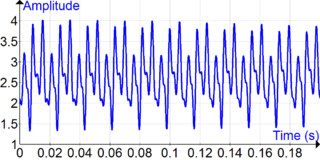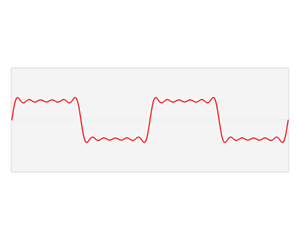Related Research Articles
Digital signal processing (DSP) is the use of digital processing, such as by computers or more specialized digital signal processors, to perform a wide variety of signal processing operations. The digital signals processed in this manner are a sequence of numbers that represent samples of a continuous variable in a domain such as time, space, or frequency. In digital electronics, a digital signal is represented as a pulse train, which is typically generated by the switching of a transistor.

In mathematics, Fourier analysis is the study of the way general functions may be represented or approximated by sums of simpler trigonometric functions. Fourier analysis grew from the study of Fourier series, and is named after Joseph Fourier, who showed that representing a function as a sum of trigonometric functions greatly simplifies the study of heat transfer.
Harmonic analysis is a branch of mathematics concerned with investigating the connections between a function and its representation in frequency. The frequency representation is found by using the Fourier transform for functions on the real line or by Fourier series for periodic functions. Generalizing these transforms to other domains is generally called Fourier analysis, although the term is sometimes used interchangeably with harmonic analysis. Harmonic analysis has become a vast subject with applications in areas as diverse as number theory, representation theory, signal processing, quantum mechanics, tidal analysis and neuroscience.

A wavelet is a wave-like oscillation with an amplitude that begins at zero, increases or decreases, and then returns to zero one or more times. Wavelets are termed a "brief oscillation". A taxonomy of wavelets has been established, based on the number and direction of its pulses. Wavelets are imbued with specific properties that make them useful for signal processing.

In mathematics, physics, electronics, control systems engineering, and statistics, the frequency domain refers to the analysis of mathematical functions or signals with respect to frequency, rather than time, as in time series. Put simply, a time-domain graph shows how a signal changes over time, whereas a frequency-domain graph shows how the signal is distributed within different frequency bands over a range of frequencies. A complex valued frequency-domain representation consists of both the magnitude and the phase of a set of sinusoids at the frequency components of the signal. Although it is common to refer to the magnitude portion as the frequency response of a signal, the phase portion is required to uniquely define the signal.
In signal processing, time–frequency analysis comprises those techniques that study a signal in both the time and frequency domains simultaneously, using various time–frequency representations. Rather than viewing a 1-dimensional signal and some transform, time–frequency analysis studies a two-dimensional signal – a function whose domain is the two-dimensional real plane, obtained from the signal via a time–frequency transform.
Stransform as a time–frequency distribution was developed in 1994 for analyzing geophysics data. In this way, the S transform is a generalization of the short-time Fourier transform (STFT), extending the continuous wavelet transform and overcoming some of its disadvantages. For one, modulation sinusoids are fixed with respect to the time axis; this localizes the scalable Gaussian window dilations and translations in S transform. Moreover, the S transform doesn't have a cross-term problem and yields a better signal clarity than Gabor transform. However, the S transform has its own disadvantages: the clarity is worse than Wigner distribution function and Cohen's class distribution function.

In signal processing, the chirplet transform is an inner product of an input signal with a family of analysis primitives called chirplets.

The Wigner distribution function (WDF) is used in signal processing as a transform in time-frequency analysis.
Geophysical survey is the systematic collection of geophysical data for spatial studies. Detection and analysis of the geophysical signals forms the core of Geophysical signal processing. The magnetic and gravitational fields emanating from the Earth's interior hold essential information concerning seismic activities and the internal structure. Hence, detection and analysis of the electric and Magnetic fields is very crucial. As the Electromagnetic and gravitational waves are multi-dimensional signals, all the 1-D transformation techniques can be extended for the analysis of these signals as well. Hence this article also discusses multi-dimensional signal processing techniques.

The method of reassignment is a technique for sharpening a time-frequency representation by mapping the data to time-frequency coordinates that are nearer to the true region of support of the analyzed signal. The method has been independently introduced by several parties under various names, including method of reassignment, remapping, time-frequency reassignment, and modified moving-window method. The method of reassignment sharpens blurry time-frequency data by relocating the data according to local estimates of instantaneous frequency and group delay. This mapping to reassigned time-frequency coordinates is very precise for signals that are separable in time and frequency with respect to the analysis window.
In statistical signal processing, the goal of spectral density estimation (SDE) or simply spectral estimation is to estimate the spectral density of a signal from a sequence of time samples of the signal. Intuitively speaking, the spectral density characterizes the frequency content of the signal. One purpose of estimating the spectral density is to detect any periodicities in the data, by observing peaks at the frequencies corresponding to these periodicities.
A Modified Wigner distribution function is a variation of the Wigner distribution function (WD) with reduced or removed cross-terms.
Bilinear time–frequency distributions, or quadratic time–frequency distributions, arise in a sub-field of signal analysis and signal processing called time–frequency signal processing, and, in the statistical analysis of time series data. Such methods are used where one needs to deal with a situation where the frequency composition of a signal may be changing over time; this sub-field used to be called time–frequency signal analysis, and is now more often called time–frequency signal processing due to the progress in using these methods to a wide range of signal-processing problems.
Choi–Williams distribution function is one of the members of Cohen's class distribution function. It was first proposed by Hyung-Ill Choi and William J. Williams in 1989. This distribution function adopts exponential kernel to suppress the cross-term. However, the kernel gain does not decrease along the axes in the ambiguity domain. Consequently, the kernel function of Choi–Williams distribution function can only filter out the cross-terms that result from the components that differ in both time and frequency center.
The cone-shape distribution function, also known as the Zhao–Atlas–Marks time-frequency distribution,, is one of the members of Cohen's class distribution function. It was first proposed by Yunxin Zhao, Les E. Atlas, and Robert J. Marks II in 1990. The distribution's name stems from the twin cone shape of the distribution's kernel function on the plane. The advantage of the cone kernel function is that it can completely remove the cross-term between two components having the same center frequency. Cross-term results from components with the same time center, however, cannot be completely removed by the cone-shaped kernel.
Fault detection, isolation, and recovery (FDIR) is a subfield of control engineering which concerns itself with monitoring a system, identifying when a fault has occurred, and pinpointing the type of fault and its location. Two approaches can be distinguished: A direct pattern recognition of sensor readings that indicate a fault and an analysis of the discrepancy between the sensor readings and expected values, derived from some model. In the latter case, it is typical that a fault is said to be detected if the discrepancy or residual goes above a certain threshold. It is then the task of fault isolation to categorize the type of fault and its location in the machinery. Fault detection and isolation (FDI) techniques can be broadly classified into two categories. These include model-based FDI and signal processing based FDI.
In the field of time–frequency analysis, several signal formulations are used to represent the signal in a joint time–frequency domain.
Time–frequency analysis for music signals is one of the applications of time–frequency analysis. Musical sound can be more complicated than human vocal sound, occupying a wider band of frequency. Music signals are time-varying signals; while the classic Fourier transform is not sufficient to analyze them, time–frequency analysis is an efficient tool for such use. Time–frequency analysis is extended from the classic Fourier approach. Short-time Fourier transform (STFT), Gabor transform (GT) and Wigner distribution function (WDF) are famous time–frequency methods, useful for analyzing music signals such as notes played on a piano, a flute or a guitar.
Spectroscopic optical coherence tomography (SOCT) is an optical imaging and sensing technique, which provides localized spectroscopic information of a sample based on the principles of optical coherence tomography (OCT) and low coherence interferometry. The general principles behind SOCT arise from the large optical bandwidths involved in OCT, where information on the spectral content of backscattered light can be obtained by detection and processing of the interferometric OCT signal. SOCT signal can be used to quantify depth-resolved spectra to retrieve the concentration of tissue chromophores, characterize tissue light scattering, and/or used as a functional contrast enhancement for conventional OCT imaging.
References
- ↑ E. Sejdić, I. Djurović, J. Jiang, "Time-frequency feature representation using energy concentration: An overview of recent advances," Digital Signal Processing, vol. 19, no. 1, pp. 153-183, January 2009.
- ↑ B. Boashash, "Note on the use of the Wigner distribution for time frequency signal analysis", IEEE Trans. on Acoust. Speech. and Signal Processing, vol. 36, issue 9, pp 1518–1521, Sept. 1988. doi : 10.1109/29.90380
- ↑ Torrence, Christopher; Compo, Gilbert P. (January 1998). "A Practical Guide to Wavelet Analysis". Bulletin of the American Meteorological Society. 79 (1): 61–78. doi:10.1175/1520-0477(1998)079<0061:APGTWA>2.0.CO;2. ISSN 0003-0007.
- ↑ Grinsted, A.; Moore, J. C.; Jevrejeva, S. (2004-11-18). "Application of the cross wavelet transform and wavelet coherence to geophysical time series". Nonlinear Processes in Geophysics. 11 (5/6): 561–566. doi: 10.5194/npg-11-561-2004 . ISSN 1023-5809.
- ↑ Tomás, R.; Li, Z.; Lopez-Sanchez, J. M.; Liu, P.; Singleton, A. (2016-06-01). "Using wavelet tools to analyse seasonal variations from InSAR time-series data: a case study of the Huangtupo landslide". Landslides. 13 (3): 437–450. doi:10.1007/s10346-015-0589-y. ISSN 1612-5118.
- ↑ Delprat, N., Escudii, B., Guillemain, P., Kronland-Martinet, R., Tchamitchian, P., and Torrksani, B. (1992). "Asymptotic wavelet and Gabor analysis: extraction of instantaneous frequencies". IEEE Transactions on Information Theory. 38 (2): 644–664. doi:10.1109/18.119728.
{{cite journal}}: CS1 maint: multiple names: authors list (link)